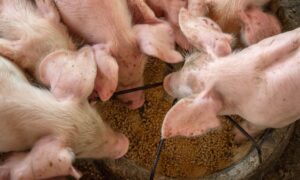For a long time it was believed that the gastrointestinal tract of animals was sterile before delivery, and that their colonization with microorganisms began during birth from contact with the mother (vertical contact with the mother’s vaginal microbiota, skin and feces), as well as other individuals and the environment (horizontally).
However, recent studies in both humans and animals suggest that microorganisms can also be found in the fetus, placenta, amniotic fluid or uterus, indicating that microbial colonization begins long before delivery.
In general, the gastrointestinal tract of animals, including pigs, is made up primarily of commensal bacteria and transitional bacteria (including pathogens) that interact with each other.
Among the microorganisms that inhabit the gastrointestinal tract are the so-called natural bacteria, which colonize the body permanently, and others, which can only be observed temporarily.
The diversity of bacterial species and their abundance increase with the age of the animals. Initially, the digestive system of piglets is colonized by facultative aerobic or anaerobic bacteria. This colonization is related to colostrum and later to milk, which mainly contains lactic acid bacteria, such as Lactobacilli and Bifidobacteria.
As the development of the animal progresses, under the influence of diet and environmental factors, the flora is modified and finally stabilizes.
All this suggests that it is important to understand the dynamics of changes in the microbiome of piglets, since it can affect the health status and productivity of adult animals.
Gastrointestinal microbiota in piglets
First days of life

At the time of birth, the gastrointestinal tract of piglets is mainly colonized by families Clostridiaceae and Enterobacteriaceae.
The study by Swords et al. showed that, 3 hours after birth, the most abundant bacteria in the gastrointestinal tract were aerobic, followed by anaerobic and coliforms.
Another study showed that the Streptococcaceae family was observed in the gastrointestinal tract of piglets 6 hours after birth, and that they were the most abundant in the period of 1 to 3 days of life, when they were replaced by Lactobacillaceae and Clostridiaceae as a result of the so-called secondary colonization process.
The activity of E. coli and Clostridium spp. is seen within the first 6 hours after birth. However, the activity of Lactobacillus spp. is visible 24 hours after delivery. The number of aerobic bacteria increases up to about seven days after birth, then their numbers decrease significantly in favor of anaerobic bacteria.
During growth
There are significant changes in the microbiome during growth.
A significant decrease in the level of Clostridium spp. can be observed and a significant increase in the count of anaerobic bacteria between 60 and 120 days of life. There is also a decrease in the number of Lactobacillus spp., that between 2 and 10 days of life constitute between 8% and 10% of the microorganisms found in the feces, while during the growth and development of the piglets their level falls below 1% on day 120.
After the weaning period, there are changes in the microbiota of the digestive system, stabilizing at 120 days of age. During this time, the intestines contain mainly anaerobic, Gram-positive, and up to 10% Gram-negative bacteria.
In this period, its composition is similar to that of adult individuals, where the main rows are found, including the Firmicutes: Clostridia spp.; Bacteroidetes, Proteobacteria, Spirochaetes and Synergistetes.
However, their ratio varies from one section of the gastrointestinal tract to another:
- In the ileum, about 95% are Firmicutes bacteria and about 5% are Proteobacteria.
- In the caecum, Bacteroideas make up about 50%, Firmicutes about 40%, Proteobacteria about 5%, and Spirochetes about 4%.
- In the central part of the colon, Firmicutes constitute about 60%, followed by Bacteroidetes 30%, Proteobacteria, Spirochetes, Synergistetes and others below around 10%.
Factors affecting the piglet’s microbiome
Changes in the microbiota of the piglets’ digestive system are significantly affected by diet and environment.
Long-term stress increases the cortisol level in piglets, which exacerbates the state of immunosuppression. As a result, it induces disorders in the secretion of saliva, gastric juice and digestive enzymes, which negatively affect intestinal peristalsis (mucositis, gastric and intestinal ulceration).
Eating and absorbing disorders lead to slower growth or weight loss. One of the main stressors in piglets, which affects the destabilization of the intestinal microbiota, is weaning.
This causes a decrease in the diversity and number of microbial populations in the gastrointestinal tract. During this period, the piglets’ intestines are more vulnerable due to changes in the structure of the intestinal barrier, which can lead to digestive disorders, diarrhea and growth retardation, as well as an increase in the mortality rate.
Furthermore, weaning is also a period of significant changes in the diet of piglets that can also lead to changes in the microbiota that inhabits their gastrointestinal tract.
Zivkovic et al. presented the concept of the so-called ‘Milk-Oriented Microbiome’ (MOM), which assumes that milk, especially the glycans it contains, can somehow control the microbiome of lactating animals.
This was confirmed in the study by Frese et al., who analyzed the fecal microbiome of pigs during the first seven weeks of their life. During this time, the piglets’ diet changed from sow’s milk only to a diet that included components of plant and animal origin.
The authors concluded that the gut microbiome of piglets was largely affected by glycans in the diet, which was reflected in the different functional possibilities of this microbiome in the periods before and after weaning.
Thus, diet can be a factor that allows a certain degree of control over the composition of the microorganisms in the digestive system.
Pathogenic bacteria
Among the pathogenic bacteria whose multiplication most frequently cause intestinal disorders are Escherichia coli, Clostridium perfringens, Salmonella choleraesuis and Salmonella typhimurium.
These bacteria produce enterotoxins that can cause rhinitis and damage the intestinal villi. As a result of bacterial infection, permeability of fluids to the intestinal lumen leading to diarrhea.
In addition, the increase in pH prevents the multiplication of beneficial lactic acid bacteria, which leads to an aggravation of the disease.
Post-weaning diarrhea is characterized by a decrease in the number of commensal bacteria, including:
- Lactobacillus sobrius,
- L. acidophilus and
- L. reuteri, and
- An increase in the count of pathogenic E. coli.
By damaging the intestinal villi, microorganisms accelerate the division of cells in the epithelium of the small intestine, leading to their desquamation. Cells cannot reach full maturity, so they do not perform their basic functions and do not participate in digestive processes.
Therefore, the piglets are not able to digest the carbohydrates that pass into the large intestine (the microbiome of the digestive system is not fully developed, unable to carry out bacterial digestion).
Source: https://porcino.info/desarrollo-de-la-microbiota-intestinal-en-lechones/






